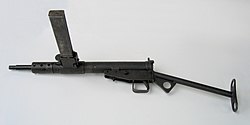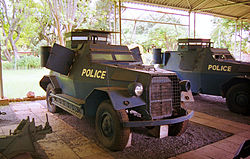
The Rhodesian Bush War , also referred to as the Rhodesian Civil War, Zimbabwe Independence War or Zimbabwean War of Liberation, as well as the Second Chimurenga, was a military conflict staged during the Decolonisation of Africa that pitted the military and police forces loyal to the Rhodesian white minority-led government of Prime-minister Ian Smith (later the Zimbabwe-Rhodesian government of Bishop Abel Muzorewa) against the guerrilla forces of the African nationalist Liberation movements in the unrecognised country of Rhodesia (later Zimbabwe-Rhodesia), between 1965 and 1979. Main combatants comprised:
Contents
- Rhodesian Security Forces equipment
- Revolvers
- Pistols
- Submachine guns
- Bolt-action rifles
- Semi-automatic rifles
- Battle rifles
- Assault rifles
- Sniper rifles
- Shotguns
- Light machine guns
- General-purpose machine guns
- Medium and Heavy machine guns
- Grenade systems
- Land mine systems
- Bombs and explosive devices
- Rocket systems
- Anti-tank rockets and Grenade launchers
- Recoilless rifles
- Mortars
- Howitzers
- Anti-aircraft guns and Autocannons
- Armoured and mine-protected vehicles
- Escort, transport and recovery vehicles
- Rail vehicles
- Helicopters
- Aircraft
- Watercraft
- Patriotic Front equipment
- Pistols 2
- Submachine guns 2
- Bolt-action rifles 2
- Semi-automatic rifles 2
- Battle rifles 2
- Assault rifles 2
- Sniper rifles 2
- Light machine guns 2
- General-purpose machine guns 2
- Medium and Heavy machine guns 2
- Grenade systems 2
- Land mine systems 2
- Bombs and explosive devices 2
- Rocket systems 2
- Anti-tank rockets and Grenade launchers 2
- Recoilless rifles 2
- Mortars 2
- Anti-aircraft guns and autocannons 2
- Armoured vehicles
- transport vehicles
- Aircraft 2
- Watercraft 2
- Notes
- See also
- References
- External links
- The Rhodesian Security Forces (RhSF) were the official armed defence and internal security forces of Rhodesia from 1963 to 1980. Subordinated to the Ministry of Defence of the Rhodesian government at the national capital Salisbury and placed since May 1977 under the command of a Combined Operations headquarters (commonly referred to as "COMOPS" or "ComOps"), [1] [2] [3] whose Commander of Combined Operations exercised operational control over all RhSF branches (including the Army's special forces), they were organized as follows:
- The Rhodesian Army
- The Rhodesian Air Force (RhAF)
- The British South Africa Police (BSAP, known informally as "The Regiment")
- The Rhodesia Prison Service (RPS)
- The Ministry of Internal Affairs (INTAF)
- The Guard Force
- The Security Force Auxiliaries (SFAs)
- The African nationalist guerrilla movements of the Patriotic Front political and military alliance (1976 – 1980):
- The Zimbabwe African National Union (ZANU) party (1963 – 1975; as ZANU-PF: 1976 – present), and its military wing the Zimbabwe African National Liberation Army (ZANLA), which received support from the People's Republic of China, North Korea, East Germany, Czechoslovakia, the Socialist Republic of Romania, SFR Yugoslavia, Algeria, Egypt, Libya, Ethiopia, Ghana, Uganda, Tanzania, Zambia and the People's Republic of Mozambique (from 1975). [4] [5] [6] [7] [8] [9] [10]
- The Zimbabwe African People's Union (ZAPU) party (1961 – 1987; 2008 – present), and its military wing the Zimbabwe People's Revolutionary Army (ZIPRA), which received support from the Soviet Union, the People's Republic of China, East Germany, Czechoslovakia, the Hungarian People's Republic, the People's Republic of Bulgaria, Cuba, Algeria, Egypt, Libya, Ghana, Botswana, Zambia and the People's Republic of Angola (from 1975). [11] [5] [12] [13]
- Other belligerents involved in the War:
- The South African Police (SAP), which deployed 12 Counter-Insurgency companies (SAPCOIN or SA PATU) to Rhodesia between 1967 and 1975 in support of the Rhodesian Security Forces, providing security to sectors of the Country's northern border. [14] [15] [2] [16] [17] In addition, the South African Air Force (SAAF) and the South African Defence Force's (SADF) Paratrooper and Special Forces units operated covertly in Rhodesia from 1967 to 1980 in close cooperation with the Rhodesian Special Air Service (SAS). [18] [19]
- The South African African National Congress (ANC) party (1912 – present), and its military wing the uMkhonto we Sizwe ("Spear of the Nation"; abbreviated MK), which operated in Rhodesia between 1966 and 1968, received support from Algeria, Egypt, Ghana, Tanzania, East Germany, Czechoslovakia, Cuba, the Soviet Union and the People's Republic of China. The ANC/MK was closely allied with ZIPRA and in August 1967 they organised a failed joint expedition into Rhodesia by crossing the Zambezi River from Zambia, which was countered by Operation Nickel, launched by the Rhodesian Security Forces with clandestine military assistance from South Africa. [20] [21] [22] [23] [24]
- The Liberation Front of Mozambique (Portuguese : Frente de Libertação de Moçambique – FRELIMO) party (1962 – present), and its military wing the Popular Forces for the Liberation of Mozambique (Portuguese : Forças Populares de Libertação de Moçambique – FPLM), which received support from the Soviet Union, East Germany, the People's Republic of Bulgaria, Czechoslovakia, Poland, SFR Yugoslavia, Sweden, Norway, Denmark, the Netherlands, Cuba, the People's Republic of China, Algeria, Libya, Egypt, Republic of the Congo, Tanzania and Zambia. [25] [5] [26]
- The Mozambican National Resistance (Portuguese : Resistência Nacional Moçambicana – RENAMO) Mozambican anti-communist guerrilla movement (1977 – present), made of political dissidents opposed to Mozambique's ruling FRELIMO party. They were recruited, organized, trained and supported by the Rhodesian Central Intelligence Organisation (CIO) and the Rhodesian Special Air Service (SAS) in 1976, who often used them for external reconnaissance missions in Mozambique between 1977 and 1980. [27] [5] [28] [29] [30]
An eclectic variety of weapons was used by all sides in the Rhodesian Bush War. The Rhodesian Security Forces were equipped with a mix of Western-made weapon systems from World War II and more modern military equipment, mainly British in origin, but also included Portuguese, Spanish, French, Belgian, West German, American, Brazilian and South African military hardware. Following the Rhodesia's unilateral declaration of independence in 1965, and the institution by the United Nations of mandatory trade sanctions between December 1966 and April 1968, which required member states to cease all trade and economic links with Rhodesia, severely restricted purchases of military hardware suitable for Counter-insurgency operations. [2] While South Africa and Portugal (until 1974) gave economic, military and limited political support to the post-UDI government, [31] [32] Rhodesia was also heavily reliant on international smuggling operations, commonly referred to as "sanction-busting", in which other armaments and non-lethal military supplies were secretly purchased (often with a third country acting as broker) from West Germany, Austria, France, Belgium, the Netherlands, Italy, Israel, Brazil, Iran (until 1979), the Philippines, South Vietnam (until 1975), Taiwan, Japan, Bermuda and Grenada, [33] [34] and smuggled to Rhodesia via clandestine air freighting through Oman, Iran, Gabon and the Comoros. [35] [36] Such illegally-purchased weaponry was complemented by the use of captured enemy arms and munitions late in the war, seized in the course of the Rhodesian Security Forces' own cross-border covert raids ("externals") against ZIPRA and ZANLA guerrilla bases in the neighbouring countries.
Unexpectedly, the UN sanctions provided the impetus for a shift towards the establishment of a domestic arms industry in Rhodesia. With South African technical assistance, the Rhodesians developed in coordination with the private sector their own military manufacturing capacity and began producing substitutes for items which could not be easily imported or were unaffordable in the international Black market. By the late 1970s, Rhodesia was producing an impressive array of military hardware, including automatic firearms, anti-personnel and anti-vehicle mines, bombs, mortars and a wide range of unique Mine and Ambush Protected (MAP) vehicles, which used commercial running gear to meet the specific requirements of the warfare being waged. [5]
During the early phase of the War, the African nationalist guerrilla movements were largely equipped with WWII-vintage Western and Eastern arms and munitions, though as the war went on, more modern Soviet, Eastern Bloc and Chinese weaponry began to play a major role, particularly after 1972. The African host countries that provided sanctuary to ZIPRA and ZANLA, mainly Tanzania, Zambia, Angola and Mozambique, served as conduits for arms shipments coming from the sponsor countries, although the guerrillas themselves made use of captured enemy stocks (which included small-arms and land mines) and they were able to manufacture some of their own anti-personnel mines, anti-vehicle roadside bombs and other home-made explosive devices. [37] [38]









































